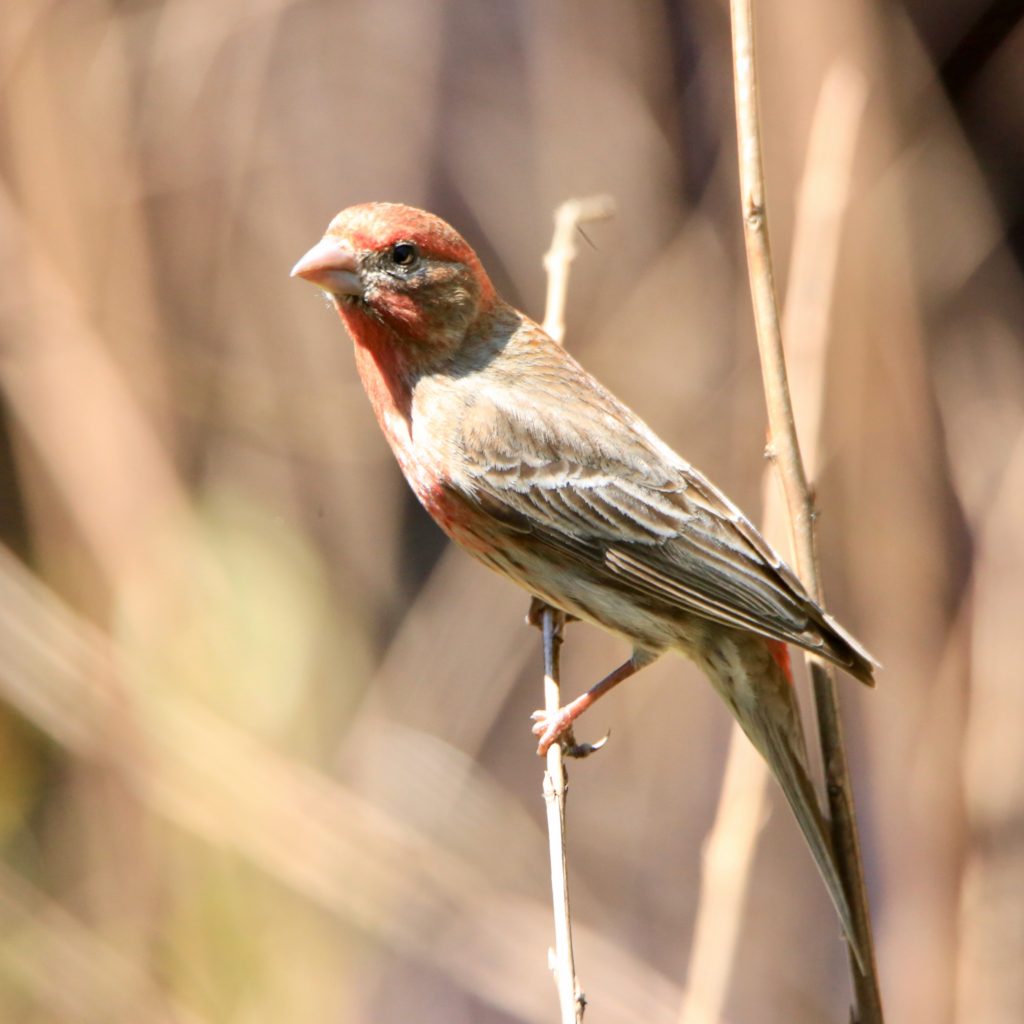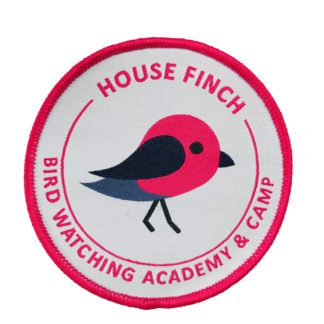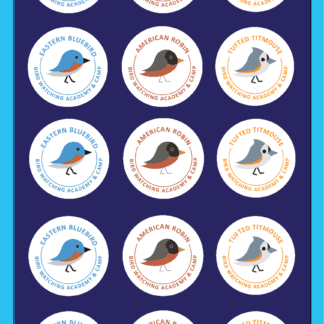
The House Finch
A House Finch is a fun bird to see while bird watching. Below are some tips to help you identify House Finchs. We have also put together a list of fun House Finch t-shirts, House Finch bird patches, bird houses, bird feeders, binoculars, stickers and other fun bird watching items.
About House Finches
A House Finch is one of the most recognized songbirds in North America distinguished by its red head and redbreast on the male birds. The house finch is a tiny bird with a fairly large beak and a flat long head.
A House Finch Color Patterns
A male house finch brags of a wine red around the face and upper breast and a light shade of brown on its back, underparts, and tail. The females, on the other hand, are not red but instead sports shades of brown streaks on its upper body underparts.





Description and Identification
House Finches are small-bodied creatures with fairly large beaks and somewhat long, flat heads. The adult finches have a long, square-tipped brown tail and a brown brown-or dull brown color across the back with some shading into deep gray on the wing feathers. The wings are short, which makes the tail seem long. Male finches are rosy-red around the face and breast, with streaky brown back, belly, and tail. Female and juvenile finches aren’t red; they are plain grayish-brown with thick, blurry streaks and an indistinctly marked face. The younger finches have a conical bill and a notched tail.
The Call of a House Finch
House Finch Size
An average adult house finch has respective measurements as follows:
- Length 13 – 14 cm
- Weight 16-27 g on average
- Wingspan 20- 25 cm

House Finch Behavior
They are fond of company and tend to come together around feeders and trees. When feeders are not close by they tend to feed on the ground eating weeds and stalks or they perch on trees. The house finch is permanent residents with their breeding habitats mostly in urban and suburban areas. The male touches bills with the female during courting and offers a variety of small bites and in turn, she mimics the behavior of a chick as he feeds her. He also feeds her during breeding, incubation, and raising of the young birds. Females are most attracted to males with the reddest head.
What House Finches Eat
House Finches mostly eat plant materials, including seeds, buds, and fruits. Almost all their diet consists of vegetable matter. Finches consume wild food, including wild mustard seeds, knotweed, thistle, mulberry, poison oak, cactus, and many other species. These birds eat cherries, apricots, peaches, pears, plums, strawberries, figs, and blackberries in orchards. They feed mainly on weed seeds, and other important food items include buds and flower parts in spring, berries, and small fruits in late summer and fall. The birds also eat a few insects, mostly small ones such as aphids, and the younger ones are fed on regurgitated seeds.
They mainly feed on seeds, berries, and grains such as millet and wheat. It has an annoying habit of causing considerable damage to orchid fruits.
Where House Finches Live and Their Habitat
House Finches are frequently spotted in city parks, backyards, urban centers, farms, and forest edges across the continent. Their original habitat was streamside trees and brush in dry country, woodland edges, scrub, and other semi-open areas. They are commonly associated with humans in cities, towns, farmlands, and especially in areas with lawns, weedy areas, trees, and buildings. In the western U.S., House Finches are also found in their native habitats of deserts, grasslands, chaparral, and open woods. In rural areas, House Finches can also be seen around barns and stables. In their native range, Finches live in natural habitats, including oak savannah, streamsides, and open coniferous forests at an elevation below 6,000 feet.
Their native habitats are deserts, grasslands, and open woods. They frequent urban parks, farms, backyards and forest edges.
Range and Migration
House Finches are native to North America and have been introduced to the eastern half of the continent and Hawaii. The birds are mostly permanent residents in the West, although some may move to lower elevations in the winter. A few House Finches are short-distance migrants, latitudinally or altitudinally, and they move from the northeastern U.S and Great Lakes to the south for the winter. Their breeding habitat is urban and sub-urban areas across North America and semi-open areas in the West from southern Canada to the Mexican state of Oaxaca.
Nesting
House Finches nest in various deciduous and coniferous trees as well as on cactus and rock ledges. These birds also nest in or on buildings, using sites like vents, street lamps, ivy, hanging planters, and ledges. Nests are built mostly by female finches. The finches are rarely seen alone outside of the breeding season, and they might form flocks as large as several hundred birds. During courtship and incubation, male finches sometimes feed female finches in a display that begins with the female gently pecking at his bill and fluttering her wings. Males may sing at any time of year, and females also spring during spring.
House Finch Life Cycle
A female lays clutches of 2 to 6 eggs from February through to August and incubates them for 12- 14 days. 11 to 19 days after hatching the young ones climb onto adjacent plants and fly away.
Ornithology
Bird Watching Academy & Camp Subscription Boxes
At Bird Watching Academy & Camp we help kids, youth, and adults get excited and involved in bird watching. We have several monthly subscription boxes that you can subscribe to. Our monthly subscription boxes help kids, youth, and adults learn about birds, bird watching, and bird conservation.
Bird Watching Binoculars for Identifying House Finches
The most common types of bird watching binoculars for viewing House Finches are 8×21 binoculars and 10×42 binoculars. Bird Watching Academy & Camp sells really nice 8×21 binoculars and 10×42 binoculars. You can view and purchase them here.
House Finch T-shirts
If you love the House Finch you should purchase a Bird Watching Academy & Camp T-shirt. To help support bird conservation we donate 10 percent to bird conservation activities.
House Finch Iron On Patches
Kids, Youth, and Adults love to collect our Bird Watching Academy & Camp iron on patches. Our bird watching patches help you keep track of the birds you have seen an identified. You can also display the patches on our Bird Watching Academy & Camp banners.
The House Finch is a great iron on patch to start your collection with. The patches are durable and can be sewn on or ironed on to just about anything.
House Finch Stickers
Stickers are a great way for you to display your love for bird watching and the House Finch. We sell a monthly subscription sticker pack. The sticker packs have 12 bird stickers. These sticker packs will help your kids learn new birds every month.
Bird Feeders For House Finches
There are many types of bird feeders. Here are our favorite bird feeders for your backyard. We use all of these bird feeders currently. Kids will have a great time watching birds eat at these bird feeders. Using this collection of bird feeders will provide a wide variety and many types of birds.
Best Bird Houses for House Finches
There are many types of bird houses. Building a bird house is always fun but can be frustrating. These 4 bird houses have become our favorites. Getting a bird house for kids to watch birds grow is always fun. We spent a little extra money on these bird houses but they have been worth the higher price and look great.









